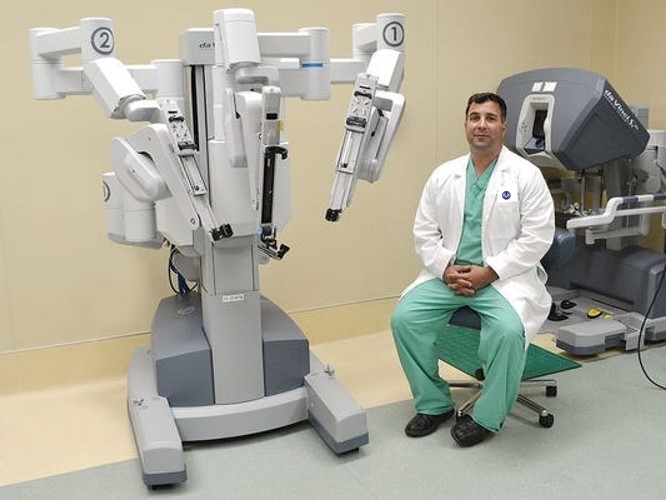The da Vinci Robotic System

Dr. Mark Kellerman (pictured) completed the first urologic surgery in Des Moines using the da Vinci system at Iowa Methodist Hospital in 2004 with the assistance of Dr. Richard Glowacki. Combined, they have performed more than 1,000 robotic surgeries since 2004. In addition, our other urologists also have extensive experience in using the da Vinci system to treat a number of urologic conditions.
Robotic surgery is a form of laparoscopic or minimally invasive surgery that utilizes a robot (da Vinci system) to assist the surgeon in completing a procedure.
Compared to traditional open surgery, robotic surgery offers a number of benefits:
- Smaller incisions
- Faster recovery time
- Reduced blood loss
- Less scarring
- Reduced pain and discomfort
- Shorter hospitalization
Conditions Treated
The conditions our urologist treat using the da Vinci robotic system include cancer (oncology) as well as reconstructive surgery.
Robotic Surgery For Urology
Robotic surgery procedures are becoming more common in treating urological conditions because they offer important benefits. These include:
- Precision
- A lower risk of complications
- Faster recovery times compared to open surgeries.
In areas where exactness and maneuverability in tight spaces are crucial, robotic surgery can be valuable. Robotic systems benefit both you and your surgeon and can help achieve better outcomes in delicate urological procedures through:
- Advanced visualization
- Increased range of instrument movement
- Better ergonomics and surgical access
What Urological Conditions Benefit from Robotic Surgery?
Some of the most common urological conditions and procedures where robotic surgery is employed include:
- Prostate cancer: Robotic-assisted radical prostatectomy is one of the most common robotic procedures in urology. It allows for the precise removal of the prostate gland and affected tissues with minimal damage to surrounding nerves, which can help preserve urinary and sexual function.
- Kidney cancer: Robotic surgery is used for:
- partial nephrectomy – removal of part of the kidney
- radical nephrectomy – removal of the entire kidney
The robotic approach helps in preserving as much of the kidney as possible, even in complex cases.
- Bladder cancer: Robotic-assisted cystectomy, the removal of all or part of the bladder, offers effective cancer control while potentially reducing recovery time.
- Ureteral surgery: Robotic surgery can reconstruct the ureters, the tubes that carry urine from the kidneys to the bladder.
- Pelvic organ prolapse: In some cases, robotic surgery may be utilized to repair pelvic organ prolapse involving the bladder, rectum, and other organs.
- Complex reconstructive procedures: Due to their enhanced precision, robotic systems are increasingly being used for complex urologic reconstructive surgeries.
Robotic-Assisted Laparoscopic Surgery
One of the most well-known robotic surgery units is the Da Vinci Surgical System. It’s an advanced form of laparoscopic surgery that enhances the surgeon's capability to perform precise and minimally invasive procedures. In traditional laparoscopic surgery, small incisions are made in the surgical area to accommodate a camera and surgical tools. In robotic-assisted laparoscopic surgery, the robotic surgical tools are inserted rather than the traditional hand-held tools.
The Da Vinci system represents the pinnacle of this technology. Several key components make up the system:
- A surgeon console equipped with controls that direct robotic arms. This setup allows the surgeon to perform procedures with extraordinary precision.
- Robotic arms that hold instruments and a high-definition 3D camera. The arms can maneuver more precisely than human hands.
- 3D high-definition vision system that provides the surgeon with a highly magnified, three-dimensional view of the surgical area.
- The system's instruments have mechanical wrists that bend and rotate more than the human wrist, allowing for enhanced dexterity and control.
Key Features and Benefits of Robotic Surgery
Robotic surgery represents a cutting-edge advancement in medical technology, offering benefits for patients undergoing many types of procedures. Key features and advantages you can expect from robotic surgery include:
High precision: Robotic surgery translates your surgeon's hand movements into smaller, more precise motions of tiny instruments within your body. This precision enhances the accuracy of the procedure.
Tremor filtration: Robotic systems reduce tremors in your surgeon's hands, ensuring smooth and accurate movement of the robotic instruments.
Enhanced visualization: With robotic surgery, your surgeon benefits from a magnified, high-definition 3D view of the surgical site. This advanced visualization significantly improves clarity and detail compared to traditional laparoscopy, allowing your surgeon to perform the procedure more confidently and accurately.
FAQs
What are the risks of robotic surgery?
Like all surgical procedures, robotic surgery carries risks such as infection, bleeding, and complications related to anesthesia. However, the precision of robotic surgery often results in fewer complications than open surgery.
How long is the recovery after robotic surgery?
Recovery times can vary, but patients often experience a quicker return to normal activities compared to traditional surgical approaches.
Is robotic surgery better than traditional surgery?
Robotic surgery offers several advantages over traditional open surgery, including smaller incisions, reduced pain and blood loss, fewer complications, and quicker recovery. The best approach for your situation depends on your specific situation and your surgeon's expertise and recommendation.
Urology Center Of Iowa
Clinic Locations
Phone
515-400-3550
Fax
515-400-3551
Address
12129 University Ave, Clive, IA 50325
Schedule Your Consultation Today
Ready to learn more about the da Vinci robotic system and how it can be used to treat your condition? Schedule an appointment today.

